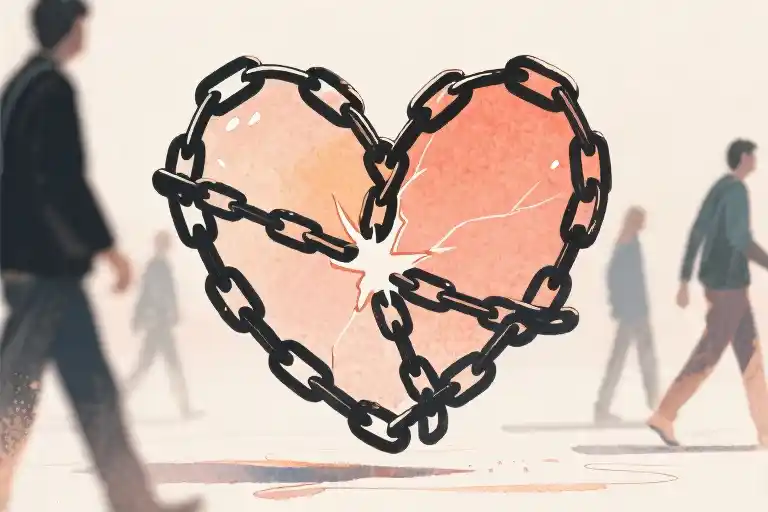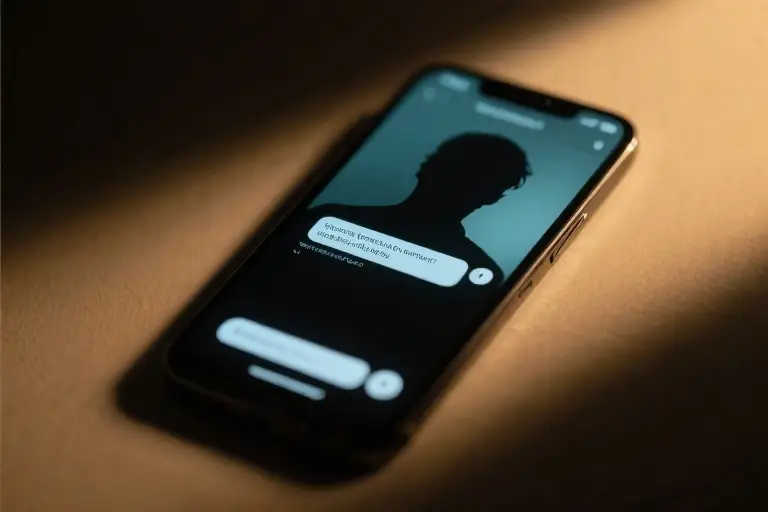It took me twenty years to say these words out loud: I’m codependent. Not the kind of dependence where you lean on others for support, but the invisible kind where you compulsively take responsibility for other people’s lives while pretending you don’t need anything yourself.
I remember the exact moment the realization hit—it was 2 a.m., and I was drafting an email to my daughter’s teacher about a group project conflict. My hands hovered over the keyboard, suddenly aware of the absurdity: my straight-A college student hadn’t asked for help. She didn’t even know I was awake. Yet there I was, orchestrating solutions for a problem that wasn’t mine to solve, mistaking control for care.
For decades, I wore my independence like armor. Raised by parents who valued self-sufficiency above all, I learned to equate needing help with failure. When I first heard the term ‘codependency’ in my thirties, I dismissed it immediately. That was for people clinging to addicts, wasn’t it? Not for someone like me—the reliable one, the problem-solver, the person who ‘had it all together.’
The irony stings now: my very resistance to the label proved its grip. True independence doesn’t compulsively prove it doesn’t need anyone; that’s just dependence wearing a disguise. My sister saw through it before I did. During a phone call about my daughter’s middle school struggles, she interrupted my frantic troubleshooting with five blunt words: ‘You’re being codependent again.’ At the time, I brushed it off as psychobabble. But the accusation stuck like a burr, itching at my consciousness until I finally researched what codependency really meant.
Here’s what I wish someone had told me earlier: Codependency isn’t about how much you give, but why you give it. When helping others becomes a way to regulate your own anxiety, when ‘being needed’ feels like oxygen—that’s when care crosses into codependency. The textbooks describe it as ‘relationship addiction,’ but for high-achievers like me, it manifests more subtly: over-editing coworkers’ reports, mediating friends’ disputes unasked, feeling physically ill when loved ones face normal struggles.
That night with my daughter’s email was my breaking point. After deleting three drafts, I finally closed the laptop and did something revolutionary: nothing. The world didn’t end. My daughter handled the conflict herself, imperfectly but sufficiently. And I began the uncomfortable work of untangling my worth from my usefulness—a journey that started with admitting one uncomfortable truth: My independence was never the whole story.
From ‘Absolute Independence’ to Codependent Awakening
Growing up, I wore my independence like a badge of honor. By fourteen, I’d perfected the art of seeming completely self-sufficient – the kind of teenager who’d rather walk five miles in the rain than ask for a ride home. This wasn’t just personality; it was survival. In our household, needing help was subtly framed as weakness, and emotional support often came with invisible strings attached. Without realizing it, I’d internalized a dangerous equation: independence = strength, dependence = failure.
When I first encountered the term ‘codependency’ in my late twenties, I dismissed it immediately. The word itself felt like an accusation, conjuring images of clingy partners or families entangled with addiction. That couldn’t be me. I was the opposite – the one who organized everyone else’s lives while carefully avoiding needing anything myself. My misinterpretation was so complete that for years, I used ‘codependent’ as shorthand for relationships I considered unhealthy because they involved ‘too much’ mutual reliance.
The irony only became clear during a strained conversation with my sister about my then-teenage daughter. I was deep in problem-solving mode, outlining strategies to fix a school situation my daughter hadn’t even asked for help with. My sister watched me spiral for twenty minutes before cutting in: ‘You do realize this is textbook codependency, right?’ Her words landed like a physical blow. I remember the coffee mug freezing halfway to my lips, the way my sweater suddenly felt too tight across my shoulders. Every muscle tensed with the urge to defend myself – but some quiet part recognized the truth in her observation.
What struck me later wasn’t just the accuracy of her diagnosis, but how perfectly it explained my lifelong contradictions. The woman who prided herself on needing nothing would lie awake worrying about other people’s problems. The ‘independent’ professional who handled crises at work would drop everything to manage her family’s minor inconveniences. My sister’s offhand comment became the first thread I’d pull in unraveling two decades of misunderstood behavior patterns.
That conversation stayed with me for three years before I finally sought answers. Three years of catching myself mid-rescue mission for coworkers, of noticing how quickly I assumed responsibility for others’ emotional states. The more I observed, the harder it became to maintain the fiction that my independence was anything but selective – robust when it came to my own needs, conspicuously absent when others’ problems entered the picture.
Looking back, I see how my rigid independence actually created the perfect conditions for codependency to thrive. By refusing to acknowledge my own needs, I’d become hyper-attuned to everyone else’s. My aversion to receiving help mutated into a compulsion to give it, often unasked. What I’d mistaken for strength was really just dependence turned inside out – the same need for connection and purpose, twisted into a form that let me pretend I wasn’t vulnerable. The realization was humbling, but also strangely freeing. After twenty years of misunderstanding myself, I finally had language for the contradiction I’d been living.
The Codependency Myths We Need to Unlearn
For years, I carried three fundamental misunderstandings about codependency that prevented me from seeing my own patterns clearly. These myths aren’t just personal blind spots—they’re cultural narratives we’ve collectively absorbed about what healthy relationships should look like.
Myth 1: Codependency Means Weakness
The first misconception I had to dismantle was the idea that codependency only affects fragile or needy people. My internal script went something like: I pay my own bills, run a household, and solve problems efficiently—how could I possibly be codependent? This false belief stems from our cultural obsession with hyper-independence as a virtue.
Reality check: Many high-achieving women operate with what therapists call “functional codependency.” We excel at caretaking precisely because we’re competent—organizing family calendars, anticipating colleagues’ needs, smoothing over conflicts before they erupt. The very skills that make us effective at work and home can mask emotional dependency patterns. Research shows that 68% of self-identified “highly independent” individuals exhibit at least three codependent traits when assessed clinically.
Myth 2: It’s Only About Addiction
When my sister first labeled me as codependent, my immediate mental rebuttal was: But nobody in my life struggles with substance abuse. Like most people, I’d absorbed the narrow portrayal of codependency as existing solely in relation to addiction—the long-suffering spouse enabling an alcoholic partner, for instance.
The truth is far more expansive. Codependency manifests whenever we derive our sense of worth from managing others’ wellbeing. That work colleague who constantly vents to you during lunch breaks? The friend whose dating disasters you analyze nightly? The adult child whose career path you stress over more than they do? These are all potential codependency hotspots unrelated to addiction.
Modern psychology recognizes codependency as a relational style that can emerge in any close connection—parent-child bonds, friendships, even professional relationships. The common thread isn’t the other person’s issues, but our compulsive need to be needed.
Myth 3: Overgiving Equals Love
This was the hardest myth to release. My excessive caretaking felt like love in its purest form—until I noticed how often my “help” came with invisible strings. There’s a crucial difference between genuine care and codependent behavior: healthy support respects boundaries, while codependency erases them.
Consider how I handled my daughter’s middle school friendship drama. My immediate urge to mediate wasn’t really about her needs—it was about my inability to tolerate her distress. True love would have meant sitting with her discomfort rather than rushing to eliminate it. As therapist boundaries expert Nedra Tawwab notes: “When we chronically override others’ autonomy to solve their problems, we’re not practicing love—we’re practicing control disguised as concern.”
At its core, codependency stems from self-worth deficits. Each time I jumped to fix someone else’s life, I was subconsciously trying to earn my place in the relationship. The paradoxical truth? Learning to not help when help isn’t requested is one of the most loving acts we can practice—for others and ourselves.
These three misconceptions form what I now call “the codependency trance”—a state where we mistake controlling behaviors for virtue, exhaustion for dedication, and self-abandonment for love. Breaking that trance begins with simple recognition: noticing when we’re relating from fear rather than trust, from lack rather than abundance.
The 5 Telltale Signs of High-Functioning Codependency
For years, I wore my ability to handle everyone else’s problems like a badge of honor. It wasn’t until I found myself canceling my own gym session to rewrite a friend’s resume—for the third time that month—that I began questioning what this pattern really meant. High-functioning codependents often appear as pillars of strength while quietly drowning in others’ emotional currents. Here’s how to spot these subtle but significant behaviors in yourself.
1. The Emotional Sponge Syndrome
You know that moment when a coworker starts venting about their marital problems during lunch? Most people offer sympathy and change the subject. Codependents like us mentally rearrange our evenings to ‘be available’ for them. I used to keep a mental ledger of friends’ crises, feeling personally responsible for soothing each one. The cruel irony? My own anxiety would spike if I dared to share my struggles during these conversations.
This automatic emotional labor extends beyond personal relationships. At work, I became the unofficial therapist for frustrated colleagues, believing that absorbing their stress made me indispensable. It took burning out to realize: being someone’s emotional landfill doesn’t make you valuable—it makes you exhausted.
2. Help as a Distraction Tactic
There’s a particular flavor of avoidance unique to codependents. When facing my own unresolved issues, I’d suddenly develop superhero-level focus on other people’s problems. My gym bag would gather dust while I spent hours researching solutions for my sister’s career pivot. My untouched therapy journal would stare accusingly as I drafted meticulous action plans for friends’ goals.
This behavior masks a painful truth: it’s easier to fix others than face our own broken parts. The rush of being needed temporarily numbs our personal anxieties. But like any quick fix, the relief fades fast—leaving both parties’ core issues untouched.
3. The Clarity Paradox
Here’s the cognitive dissonance no one warns you about: I could outline my best friend’s relationship patterns with clinical precision, yet remained mystified by my own recurring romantic disasters. Codependents often possess laser insight into others’ lives while stumbling through personal fog.
This imbalance manifests in practical ways too. I’d remember my partner’s medication schedule better than my own, could list my mother’s dietary restrictions but forget my food allergies. The more I prioritized mapping others’ needs, the blurrier my self-awareness became—like a photographer unable to appear in their own carefully composed shots.
4. The Anticipatory Apology Reflex
Healthy people apologize when they’ve actually wronged someone. Codependents say sorry like it’s punctuation. I once apologized to a barista for handing her a crumpled dollar bill. When my neighbor’s package went missing, I felt guilty for not watching her doorstep like some suburban surveillance system.
This hyper-responsibility extends to emotional realms too. If someone seemed upset near me, I’d immediately assume I caused it and scramble to fix their mood. The unspoken belief: everyone’s emotional state is mine to manage. It’s exhausting playing emotional air traffic control for an entire social circle.
5. The Boundary Blind Spot
Codependents don’t ignore boundaries—we genuinely struggle to perceive them. Like someone colorblind to social cues, I’d routinely cross lines I didn’t realize existed. Checking in ‘just to see how that difficult conversation went’ became micromanaging. Offering unsolicited advice masked as ‘just brainstorming’ eroded others’ autonomy.
The wake-up call came when my teenage daughter snapped, ‘I didn’t ask you to solve this!’ Her frustration mirrored countless subtle reactions I’d missed over the years—the stiffened posture when offering help, the delayed text responses after my ‘suggestions.’ Healthy relationships require recognizing where you end and others begin.
Recognizing these patterns isn’t about self-flagellation—it’s about reclaiming agency. What shocked me most wasn’t seeing these behaviors in myself, but realizing how long I’d mistaken them for virtues. That resume I kept rewriting? My friend never used it. The gym sessions I skipped? Those were my stress relief. The math of codependency never adds up, but the first step toward balance begins with honest accounting.
The Messy First Steps Toward Change
My first attempt at setting boundaries was a spectacular failure. I remember the scene vividly: my neighbor stood at my doorstep, tearfully explaining her marital problems for the third time that month. My usual script would have involved brewing tea, offering tissues, and spending hours brainstorming solutions she never implemented. This time, armed with my new awareness of codependency, I tried something different.
“I’m so sorry you’re going through this,” I said, palms sweating. “But I don’t think I’m the right person to help with this.” The words tasted like betrayal. Her bewildered expression made me instantly backtrack: “I mean… unless you really need to talk right now?” Within minutes, I was deep in advice-giving mode, exactly where I’d sworn not to be.
Why Small Shifts Matter More Than Grand Gestures
That failed experiment taught me something crucial: recovery from codependency isn’t about perfect boundaries erected overnight. It’s about the daily five-minute practices that slowly rewire automatic responses:
- The ‘Do Nothing’ Drill: When someone shares a problem, practice simply saying “That sounds tough” without following up with solutions. Set a timer if you must.
- The 24-Hour Rule: For non-emergencies, make it a policy to wait one full day before offering help. Often, the urge passes.
- The Mirror Check: Ask yourself: “Am I doing this because they need it, or because I need to feel needed?” The answer stings sometimes.
Books That Helped Me See Differently
What finally moved the needle for me wasn’t dramatic breakthroughs, but quiet moments with these resources:
- Codependent No More by Melody Beattie – The chapter on detachment felt like it was written about my life
- The Disease To Please by Harriet Braiker – Explained why “helping” left me exhausted rather than fulfilled
- Set Boundaries, Find Peace by Nedra Tawwab – Gave practical scripts for situations I actually faced
The turning point came when I noticed my annotations shifting from “This isn’t me” to “Oh. This is exactly me.”
Permission To Stumble
Here’s what I wish someone had told me earlier: Relapse is part of recovery. You’ll catch yourself:
- Drafting emails for your adult child
- Feeling responsible for coworkers’ moods
- Lying awake solving problems no one asked you to solve
The progress happens when you notice these moments sooner each time – not when you eliminate them completely. My metric changed from “Did I fail today?” to “Did I catch myself faster than last week?”
Change begins when we trade the fantasy of perfect boundaries for the reality of imperfect but consistent effort. Some days you’ll hold the line. Other days you’ll cave and then course-correct. Both count as progress in this unlearning.
The Gift of Acknowledgment
Admitting my codependency wasn’t an indictment of my character—it was the first step toward reclaiming my emotional freedom. For years, I’d equated being needed with being loved, mistaking constant availability for strength. That realization didn’t diminish my capacity for care; it simply gave that care healthier parameters.
Healthy boundaries became my compass. Where I once rushed to fix every problem presented to me, I learned the difference between supporting and enabling. That shift didn’t happen overnight. My first attempt at saying “I can’t solve this for you” to my daughter left me physically nauseous, as if I’d committed some unthinkable betrayal. But with practice, the guilt lessened. I discovered that relationships deepen when we allow others their own struggles.
What surprised me most was how my codependency recovery revealed neglected parts of myself. The hours I’d spent orchestrating others’ lives became space for rediscovering abandoned hobbies and silenced desires. That neglected paint set in my closet? It’s now responsible for the terrible but joyful landscapes hanging in my kitchen. The college French textbook I’d “never had time for” helps me stumble through pastry recipes on weekends.
This journey taught me that codependency often masks a quiet fear: If I’m not needed, will I still matter? The answer came gradually—through mornings spent reading instead of problem-solving, through conversations where I listened without strategizing responses. My value wasn’t contingent on my utility.
For your reflection: When did you first recognize your pattern of over-responsibility? Was it a specific moment, or a slow dawning? That awareness—however it comes—is worth honoring.
Next steps you might consider:
- Download our Codependency Self-Assessment (link)
- Join the Boundaries Without Guilt 5-day challenge
- Share your turning point in our community forum using #MyAwarenessMoment
The path isn’t about becoming someone new, but uncovering who you’ve always been beneath the layers of overgiving. That person? They’re more than enough.





